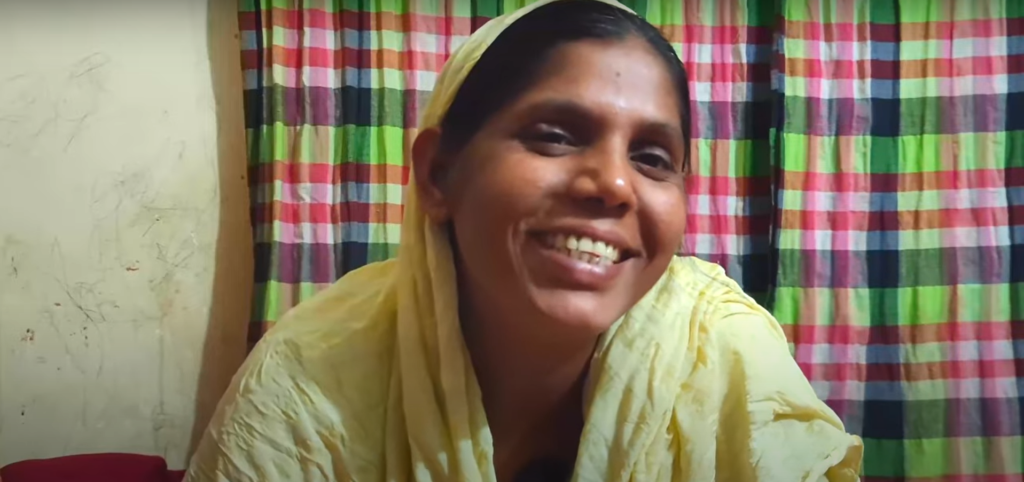Our Garment Worker Diaries blog for the week of May 17th was originally hosted by Fashion Revolution, by whom we were invited to be guest writers. You can read the original full blog, “Garment Workers and Climate Change: The Socioeconomic Link” on their site. What follows below is a reproduction of the original post…
Shila was forced to leave her home when sea level rise contributed to its destruction. Her parents were unable to afford to continue paying for her education, so she became the caretaker of another family’s baby. Eventually, Shila found her way to Dhaka. She believes she was born sometime in the autumn of 1986, and she’s been a garment worker since 2000.
Shila is one of the 1,300 workers participating in the Garment Worker Diaries study, which has been conducting interviews with workers continually for the past 34 months, once per week, 52 weeks per year. Some respondents drop out of the study, others remain with us for a long time –Shila has been part of the study since June 2018. In late December 2020, she sat down with our film crew to discuss her life story, her daily routine, her work, and her aspirations for both herself and her son.
Shila’s story is at times tragic, mundane and uplifting. It’s unique, and we encourage you to watch the entire interview. But, there are other garment workers in much the same position as Shila. More specifically, there are many other female garment workers who have had and will have experiences similar to Shila’s—at the intersection of climate change, gender inequality, and the gruelling economics of global supply chains.
Like Shila, nearly 90% of the garment workers in Bangladesh migrate from somewhere else. Female garment workers are slightly more likely to migrate than male garment workers. While the majority of both women and men migrate for reasons related to economic hardship, men are slightly more likely than women to report that they migrated for reasons related to economic opportunity or because they prefer city-style living (as opposed to life in the villages). Women, on the other hand, are slightly more likely than men to say they were forced to migrate, and they are much more likely than men to report that they migrated to get married or to follow their spouse or another family member. We know this because in August 2020 we interviewed the workers participating in the GWD study about their migration experience.
Also like Shila, workers are aware of the impact of climate change and the local effects of air pollution. A majority, 62%, answered “Yes” to the question “Are you concerned about climate change?” Here are a few of the reasons why, in their own words:
“People are being affected with various diseases and there are more storms and tidal surges due to climate change.” – Female worker, age 23, working in the garment industry for 3.5 years.
“People are being harmed economically. Crops are being damaged as there is no rain at the time when it is supposed to rain.” – Male security guard, age 50, working in the garment industry for 4 months.
“Black smoke emitted from cars, factories, and brick kilns is polluting the environment and people are getting sick from it. Medical treatment is very expensive. I fear that if this continues, it will be difficult for people to live a healthy life.” – Female machine operator, age 30, working in the garment industry for 12 years.”
The workers’ answers are consistent with what other data tell us: Bangladesh is consistently ranked as one of the most at-risk countries for weather-related events. Numerous advocacy groups, non-governmental organizations, academic journals and media outlets have been and will continue to call attention to the particular risk that Bangladesh faces.
But the workers are not well-equipped to deal with the consequences of climate change, and women workers, like Shila, are especially vulnerable. They have already migrated to improve their standard of living, but their earnings do not give them the financial cushion they may need to cope with the disruptions brought by climate change. For example, during the 12-month period from April 2020 to March 2021, the typical salary earned by female garment workers in Bangladesh was about Tk. 8,300, while the typical salary earned by male garment workers was about Tk. 10,100 (about USD $117/EUR €96/GBP £83).
If we look at the typical monthly work hours for female and male garment workers for that same time period, we see that women typically worked about 198 hours per month while men typically worked about 214 hours per month. This means on the whole that women earn about Tk. 42/hour to men’s Tk. 47/hour. Another way to put it is men earn about 12% more than women.
Shila, and workers like her, work long hours to make ends meet for wages that provide little buffer against the potential economic disruption of climate change. It is clear that human rights and the environment are deeply connected; the women who make our clothes and the children they raise could be disproportionately affected by the negative impacts of climate change. Watch the video to learn more.
Further Reading
International Women’s Day: Women’s rights and the environment in fashion
Fashion Revolution Podcast: Garment Worker Diaries
